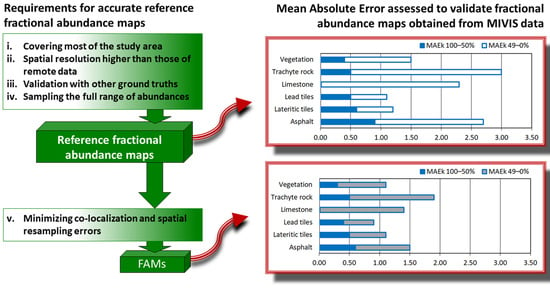Spatial Validation of Spectral Unmixing Results: A Case Study of Venice City
Abstract
:1. Introduction
2. Materials and Methods
2.1. Reference Map and Reference Spectra
2.1.1. In Situ and Remote Data
2.1.2. Reference Map Meeting All Requirements
2.1.3. Reference Spectra
2.2. Preprocessing and Spectral Unmixing Processing Chains
2.3. Validation Methods of the Spectral Unmixing Results
3. Results
3.1. Fractional Abundance Models (FAMs)
3.2. Methods for Spectral Validating the Pixel Constituent Spectra
3.3. Methods for Spatial Validating the Fractional Abundance Maps
4. Discussion and Conclusions
- The average spectral accuracy evaluated with RMSk values is equal to 0.025 and the sensor characteristics and the accuracy of the reference endmember set and LMM affect about of 73% of these values;
- The average spectral accuracies evaluated with the SADk and aSSMnk values are equal to 0.345 and 0.595 and the sensor characteristics and the accuracy of the reference endmember set and LMM affect more than 82% of these values;
- The average spatial accuracy evaluated with MAEk-Totals values by using FAMs is equal to 1.32 and the sensor characteristics and the accuracy of the reference endmember set and LMM affect about of 78% of these values;
- The average spatial accuracy evaluated with MAEk-Totals values by using reference fractional abundance maps is equal to 1.97 and the sensor characteristics and the accuracy of the reference endmember set and LMM affect about of 58% and the errors in co-localization and spatial resampling affect about of 29% of these values.
Funding
Data Availability Statement
Acknowledgments
Conflicts of Interest
References
- Sabins, F.F., Jr. Remote Sensing: Principles and Interpretation; Chevron Oil Field Research Co.: San Ramon, CA, USA, 1986. [Google Scholar]
- Cracknell, A.P. Review Article Synergy in Remote Sensing-What’s in a Pixel? Int. J. Remote Sens. 1998, 19, 2025–2047. [Google Scholar] [CrossRef]
- Jimenez, L.I.; Martin, G.; Plaza, A. A New Tool for Evaluating Spectral Unmixing Applications for Remotely Sensed Hyperspectral Image Analysis. In Proceedings of the International Conference Geographic Object-Based Image Analysis (GEOBIA), Rio de Janeiro, Brazil, 7–9 May 2012; pp. 1–5. [Google Scholar]
- Keshava, N.; Mustard, J.F. Spectral Unmixing. IEEE Signal Process. Mag. 2002, 19, 44–57. [Google Scholar] [CrossRef]
- Somers, B.; Asner, G.P.; Tits, L.; Coppin, P. Endmember Variability in Spectral Mixture Analysis: A Review. Remote Sens. Environ. 2011, 115, 1603–1616. [Google Scholar] [CrossRef]
- Ichoku, C.; Karnieli, A. A Review of Mixture Modeling Techniques for Sub-Pixel Land Cover Estimation. Remote Sens. Rev. 1996, 13, 161–186. [Google Scholar] [CrossRef]
- Adams, J.B.; Smith, M.O.; Johnson, P.E. Spectral Mixture Modeling: A New Analysis of Rock and Soil Types at the Viking Lander 1 Site. J. Geophys. Res. 1986, 91, 8098. [Google Scholar] [CrossRef]
- Settle, J.; Drake, N. Linear Mixing and the Estimation of Ground Cover Proportions. Int. J. Remote Sens. 1993, 14, 1159–1177. [Google Scholar] [CrossRef]
- Borel, C.C.; Gerstl, S.A.W. Nonlinear Spectral Mixing Models for Vegetative and Soil Surfaces. Remote Sens. Environ. 1994, 47, 403–416. [Google Scholar] [CrossRef]
- Gillespie, A. Interpretation of Residual Images: Spectral Mixture Analysis of AVIRIS Images, Owens Valley, California. In Proceedings of the Second Airborne Visible/Infrared Imaging Spectrometer (AVIRIS) Workshop, 4–5 June 1990; Jet Propulsion Laboratory: La Cañada Flintridge, CA, USA, 1990; pp. 243–270. [Google Scholar]
- Sabol, D.E.; Adams, J.B.; Smith, M.O. Quantitative Subpixel Spectral Detection of Targets in Multispectral Images. J. Geophys. Res. 1992, 97, 2659. [Google Scholar] [CrossRef]
- Shi, C.; Wang, L. Incorporating Spatial Information in Spectral Unmixing: A Review. Remote Sens. Environ. 2014, 149, 70–87. [Google Scholar] [CrossRef]
- Bioucas-Dias, J.M.; Plaza, A.; Dobigeon, N.; Parente, M.; Du, Q.; Gader, P.; Chanussot, J. Hyperspectral Unmixing Overview: Geometrical, Statistical, and Sparse Regression-Based Approaches. IEEE J. Sel. Top. Appl. Earth Obs. Remote Sens. 2012, 5, 354–379. [Google Scholar] [CrossRef]
- Shahid, K.T.; Schizas, I.D. Spatial-Aware Hyperspectral Nonlinear Unmixing Autoencoder With Endmember Number Estimation. IEEE J. Sel. Top. Appl. Earth Obs. Remote Sens. 2022, 15, 20–41. [Google Scholar] [CrossRef]
- Yu, J.; Chen, D.; Lin, Y.; Ye, S. Comparison of Linear and Nonlinear Spectral Unmixing Approaches: A Case Study with Multispectral TM Imagery. Int. J. Remote Sens. 2017, 38, 773–795. [Google Scholar] [CrossRef]
- Cavalli, R.M.; Pascucci, S.; Pignatti, S. Optimal Spectral Domain Selection for Maximizing Archaeological Signatures: Italy Case Studies. Sensors 2009, 9, 1754–1767. [Google Scholar] [CrossRef] [Green Version]
- Rashed, T.; Weeks, J.R.; Roberts, D.; Rogan, J.; Powell, R. Measuring the Physical Composition of Urban Morphology Using Multiple Endmember Spectral Mixture Models. Photogramm. Eng. Remote Sens. 2003, 69, 1011–1020. [Google Scholar] [CrossRef] [Green Version]
- Demarchi, L.; Canters, F.; Chan, J.C.-W.; Van de Voorde, T. Multiple Endmember Unmixing of CHRIS/Proba Imagery for Mapping Impervious Surfaces in Urban and Suburban Environments. IEEE Trans. Geosci. Remote Sens. 2012, 50, 3409–3424. [Google Scholar] [CrossRef]
- Deng, C.; Wu, C. The Use of Single-Date MODIS Imagery for Estimating Large-Scale Urban Impervious Surface Fraction with Spectral Mixture Analysis and Machine Learning Techniques. ISPRS J. Photogramm. Remote Sens. 2013, 86, 100–110. [Google Scholar] [CrossRef]
- Wang, H.; Zhang, X.; Du, S.; Bai, L.; Liu, B. Mapping Annual Urban Evolution Process (2001–2018) at 250 m: A Normalized Multi-Objective Deep Learning Regression. Remote Sens. Environ. 2022, 278, 113088. [Google Scholar] [CrossRef]
- Malleswara Rao, J.; Siddiqui, A.; Maithani, S.; Kumar, P. Hyperspectral and Multispectral Data Fusion Using Fast Discrete Curvelet Transform for Urban Surface Material Characterization. Geocarto Int. 2022, 37, 2018–2030. [Google Scholar] [CrossRef]
- Tooke, T.R.; Coops, N.C.; Goodwin, N.R.; Voogt, J.A. Extracting Urban Vegetation Characteristics Using Spectral Mixture Analysis and Decision Tree Classifications. Remote Sens. Environ. 2009, 113, 398–407. [Google Scholar] [CrossRef]
- Cavalli, R.; Fusilli, L.; Pascucci, S.; Pignatti, S.; Santini, F. Hyperspectral Sensor Data Capability for Retrieving Complex Urban Land Cover in Comparison with Multispectral Data: Venice City Case Study (Italy). Sensors 2008, 8, 3299–3320. [Google Scholar] [CrossRef]
- Heylen, R.; Parente, M.; Gader, P. A Review of Nonlinear Hyperspectral Unmixing Methods. IEEE J. Sel. Top. Appl. Earth Obs. Remote Sens. 2014, 7, 1844–1868. [Google Scholar] [CrossRef]
- Shimabukuro, Y.; Carvalho, V.; Rudorff, B. NOAA-AVHRR Data Processing for the Mapping of Vegetation Cover. Int. J. Remote Sens. 1997, 18, 671–677. [Google Scholar] [CrossRef] [Green Version]
- Shimabukuro, Y.E.; Smith, J.A. The Least-Squares Mixing Models to Generate Fraction Images Derived from Remote Sensing Multispectral Data. IEEE Trans. Geosci. Remote Sens. 1991, 29, 16–20. [Google Scholar] [CrossRef]
- Boardman, J.W. Inversion of Imaging Spectrometry Data Using Singular Value Decomposition. In Proceedings of the 12th Canadian Symposium on Remote Sensing Geoscience and Remote Sensing Symposium, Vancouver, BC, Canada, 10–14 July 1989; IEEE: Piscataway, NJ, USA, 1989; Volume 4, pp. 2069–2072. [Google Scholar]
- Wei, J.; Wang, X. An Overview on Linear Unmixing of Hyperspectral Data. Math. Probl. Eng. 2020, 2020, 3735403. [Google Scholar] [CrossRef]
- Nidamanuri, R.R.; Ramiya, A.M. Spectral Identification of Materials by Reflectance Spectral Library Search. Geocarto Int. 2014, 29, 609–624. [Google Scholar] [CrossRef]
- Matoušková, E.; Pavelka, K.; Ibrahim, S. Creating a Material Spectral Library for Plaster and Mortar Material Determination. Materials 2021, 14, 7030. [Google Scholar] [CrossRef] [PubMed]
- Jia, S.; Qian, Y. Spectral and Spatial Complexity-Based Hyperspectral Unmixing. IEEE Trans. Geosci. Remote Sens. 2007, 45, 3867–3879. [Google Scholar]
- Dobigeon, N.; Tits, L.; Somers, B.; Altmann, Y.; Coppin, P. A Comparison of Nonlinear Mixing Models for Vegetated Areas Using Simulated and Real Hyperspectral Data. IEEE J. Sel. Top. Appl. Earth Obs. Remote Sens. 2014, 7, 1869–1878. [Google Scholar] [CrossRef] [Green Version]
- Cavalli, R.M. Capability of Remote Sensing Images to Distinguish the Urban Surface Materials: A Case Study of Venice City. Remote Sens. 2021, 13, 3959. [Google Scholar] [CrossRef]
- Halimi, A.; Bioucas-Dias, J.M.; Dobigeon, N.; Buller, G.S.; McLaughlin, S. Fast Hyperspectral Unmixing in Presence of Nonlinearity or Mismodeling Effects. IEEE Trans. Comput. Imaging 2016, 3, 146–159. [Google Scholar] [CrossRef] [Green Version]
- Debba, P.; Carranza, E.J.; van der Meer, F.D.; Stein, A. Abundance Estimation of Spectrally Similar Minerals by Using Derivative Spectra in Simulated Annealing. IEEE Trans. Geosci. Remote Sens. 2006, 44, 3649–3658. [Google Scholar] [CrossRef]
- Williams, M.; Parody, R.; Fafard, A.; Kerekes, J.; van Aardt, J. Validation of Abundance Map Reference Data for Spectral Unmixing. Remote Sens. 2017, 9, 473. [Google Scholar] [CrossRef] [Green Version]
- Yang, J.; He, Y.; Oguchi, T. An Endmember Optimization Approach for Linear Spectral Unmixing of Fine-Scale Urban Imagery. Int. J. Appl. Earth Obs. Geoinf. 2014, 27, 137–146. [Google Scholar] [CrossRef]
- Walton, J.T. Subpixel Urban Land Cover Estimation. Photogramm. Eng. Remote Sens. 2008, 74, 1213–1222. [Google Scholar] [CrossRef] [Green Version]
- Williams, M.D.; Kerekes, J.P.; Aardt, J.V. Application of Abundance Map Reference Data for Spectral Unmixing. Remote Sens. 2017, 9, 793. [Google Scholar] [CrossRef] [Green Version]
- Milella, M. Saperi Della Cultura e Agire Formativo; Morlacchi Editore: Perugia, Italy, 2003. [Google Scholar]
- Congalton, R.G.; Green, K. Assessing the Accuracy of Remotely Sensed Data: Principles and Practices; CRC Press: Boca Raton, FL, USA, 2019. [Google Scholar]
- Olofsson, P.; Foody, G.M.; Stehman, S.V.; Woodcock, C.E. Making Better Use of Accuracy Data in Land Change Studies: Estimating Accuracy and Area and Quantifying Uncertainty Using Stratified Estimation. Remote Sens. Environ. 2013, 129, 122–131. [Google Scholar] [CrossRef]
- Schwieder, M.; Leitão, P.; Suess, S.; Senf, C.; Hostert, P. Estimating Fractional Shrub Cover Using Simulated EnMAP Data: A Comparison of Three Machine Learning Regression Techniques. Remote Sens. 2014, 6, 3427–3445. [Google Scholar] [CrossRef] [Green Version]
- Kim, S.M.; Yoon, S.H.; Ju, S.; Heo, J. Monitoring and Analyzing Water Area Variation of Lake Enriquillo, Dominican Republic by Integrating Multiple Endmember Spectral Mixture Analysis and MODIS Data. Ecol. Resilient Infrastruct. 2018, 5, 59–71. [Google Scholar]
- Kruse, F.A. Comparison of AVIRIS and Hyperion for Hyperspectral Mineral Mapping. In Proceedings of the 11th JPL Airborne Geoscience Workshop, Pasadena, CA, USA, 4–8 March 2002; Volume 4. [Google Scholar]
- Puyou-Lascassies, P.; Flouzat, G.; Gay, M.; Vignolles, C. Validation of the Use of Multiple Linear Regression as a Tool for Unmixing Coarse Spatial Resolution Images. Remote Sens. Environ. 1994, 49, 155–166. [Google Scholar] [CrossRef]
- Abrams, M.; Cavalli, R.; Pignatti, S. Intercalibration and Fusion of Satellite and Airborne Multispectral Data over Venice. In Proceedings of the 2003 2nd GRSS/ISPRS Joint Workshop on Remote Sensing and Data Fusion over Urban Areas, Berlin, Germany, 22–23 May 2003; IEEE: Piscataway, NJ, USA, 2003; pp. 241–242. [Google Scholar]
- Dati.Venezia.It|Dati Della Città Di Venezia. Available online: https://dati.venezia.it/ (accessed on 18 May 2022).
- Ramses: A Preservation and Protection Project for Venice. Available online: http://smu.insula.it/index.php@option=com_content&view=article&id=15&Itemid=111.html (accessed on 16 May 2022).
- Parker, J.A.; Kenyon, R.V.; Troxel, D.E. Comparison of Interpolating Methods for Image Resampling. IEEE Trans. Med. Imaging 1983, 2, 31–39. [Google Scholar] [CrossRef] [PubMed]
- Bassani, C.; Cavalli, M.; Palombo, A.; Pignatti, S.; Madonna, F. Laboratory Activity for a New Procedure of MIVIS Calibration and Relative Validation with Test Data. 2006. Available online: https://www.annalsofgeophysics.eu/index.php/annals/article/view/3148 (accessed on 2 May 2022).
- Berk, A.; Bernstein, L.; Anderson, G.; Acharya, P.; Robertson, D.; Chetwynd, J.; Adler-Golden, S. MODTRAN Cloud and Multiple Scattering Upgrades with Application to AVIRIS. Remote Sens. Environ. 1998, 65, 367–375. [Google Scholar] [CrossRef]
- Bassani, C.; Cavalli, R.M.; Antonelli, P. Influence of Aerosol and Surface Reflectance Variability on Hyperspectral Observed Radiance. Atmos. Meas. Tech. 2012, 5, 1193–1203. [Google Scholar] [CrossRef]
- Bassani, C.; Cavalli, R.M.; Pignatti, S. Aerosol Optical Retrieval and Surface Reflectance from Airborne Remote Sensing Data over Land. Sensors 2010, 10, 6421–6438. [Google Scholar] [CrossRef] [PubMed] [Green Version]
- Townshend, J.R.; Justice, C.O.; Gurney, C.; McManus, J. The Impact of Misregistration on Change Detection. IEEE Trans. Geosci. Remote Sens. 1992, 30, 1054–1060. [Google Scholar] [CrossRef] [Green Version]
- Avanzi, G.; Bianchi, R.; Cavalli, R.M.; Fiumi, L.; Marino, C.M.; Pignatti, S. Use of MIVIS Navigational Data for Precise Aircraft Positioning and Attitude Estimation. In Proceedings of the Remote Sensing for Geography, Geology, Land Planning, and Cultural Heritage, Taormina, Italy, 23–26 September 1996; International Society for Optics and Photonics: Bellingham, WA, USA, 1996; Volume 2960, pp. 184–192. [Google Scholar]
- Boardman, J.; Kruse, F. Automated Spectral Analysis: A Geological Example Using AVIRIS Data, North Grapevine Mountains, Nevada. In Proceedings of the Tenth Thematic Conference on Geologic Remote Sensing, Environmental Research Institute of Michigan, San Antonio, TX, USA, 9–12 May 1994; pp. 1407–1418. [Google Scholar]
- Roberts, D.A.; Gardner, M.; Church, R.; Ustin, S.; Scheer, G.; Green, R.O. Mapping Chaparral in the Santa Monica Mountains Using Multiple Endmember Spectral Mixture Models. Remote Sens. Environ. 1998, 65, 267–279. [Google Scholar] [CrossRef]
- Cavalli, R. Retrieval of Sea Surface Temperature from MODIS Data in Coastal Waters. Sustainability 2017, 9, 2032. [Google Scholar] [CrossRef] [Green Version]
- Altmann, Y.; Halimi, A.; Dobigeon, N.; Tourneret, J.-Y. Supervised Nonlinear Spectral Unmixing Using a Postnonlinear Mixing Model for Hyperspectral Imagery. IEEE Trans. Image Process. 2012, 21, 3017–3025. [Google Scholar] [CrossRef] [Green Version]
- Adams, J.B. Imaging Spectroscopy: Interpretation Based on Spectral Mixture Analysis. In Remote Geochemical Analysis: Elemental and Mineralogical Composition; Pieters, C.M., Englert, P.A.J., Eds.; Cambridge University Press: New York, NY, USA, 1993; pp. 145–166. [Google Scholar]
- Kruse, F.A.; Lefkoff, A.; Boardman, J.; Heidebrecht, K.; Shapiro, A.; Barloon, P.; Goetz, A. The Spectral Image Processing System (SIPS)—Interactive Visualization and Analysis of Imaging Spectrometer Data. Remote Sens. Environ. 1993, 44, 145–163. [Google Scholar] [CrossRef]
- Cavalli, R.; Betti, M.; Campanelli, A.; Cicco, A.; Guglietta, D.; Penna, P.; Piermattei, V. A Methodology to Assess the Accuracy with Which Remote Data Characterize a Specific Surface, as a Function of Full Width at Half Maximum (FWHM): Application to Three Italian Coastal Waters. Sensors 2014, 14, 1155–1183. [Google Scholar] [CrossRef]
- Gupta, H.V.; Kling, H.; Yilmaz, K.K.; Martinez, G.F. Decomposition of the Mean Squared Error and NSE Performance Criteria: Implications for Improving Hydrological Modelling. J. Hydrol. 2009, 377, 80–91. [Google Scholar] [CrossRef] [Green Version]
- Cavalli, R.M. Local, Daily, and Total Bio-Optical Models of Coastal Waters of Manfredonia Gulf Applied to Simulated Data of CHRIS, Landsat TM, MIVIS, MODIS, and PRISMA Sensors for Evaluating the Error. Remote Sens. 2020, 12, 1428. [Google Scholar] [CrossRef]
- Deng, Y.; Wu, C. Development of a Class-Based Multiple Endmember Spectral Mixture Analysis (C-MESMA) Approach for Analyzing Urban Environments. Remote Sens. 2016, 8, 349. [Google Scholar] [CrossRef]
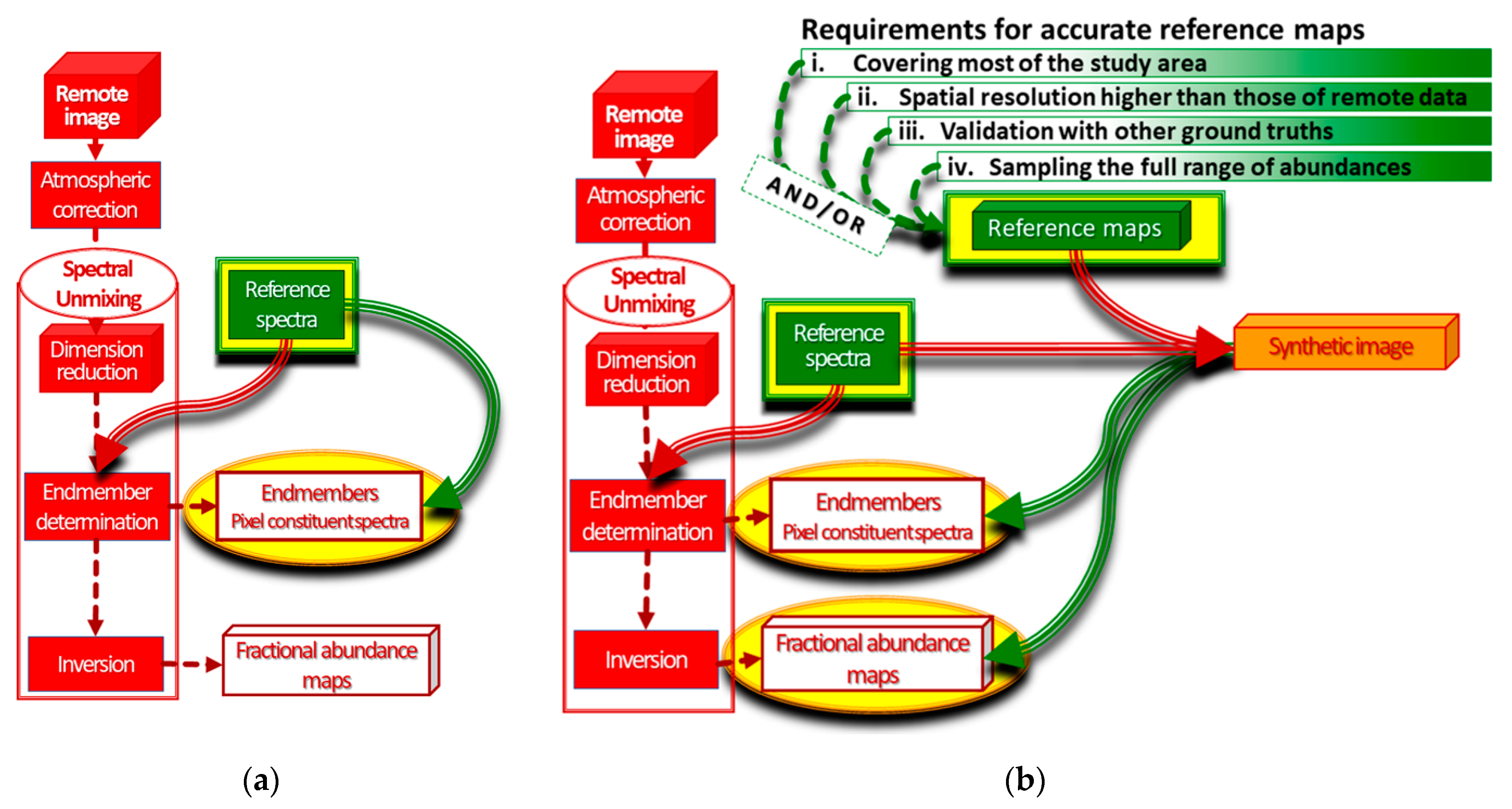
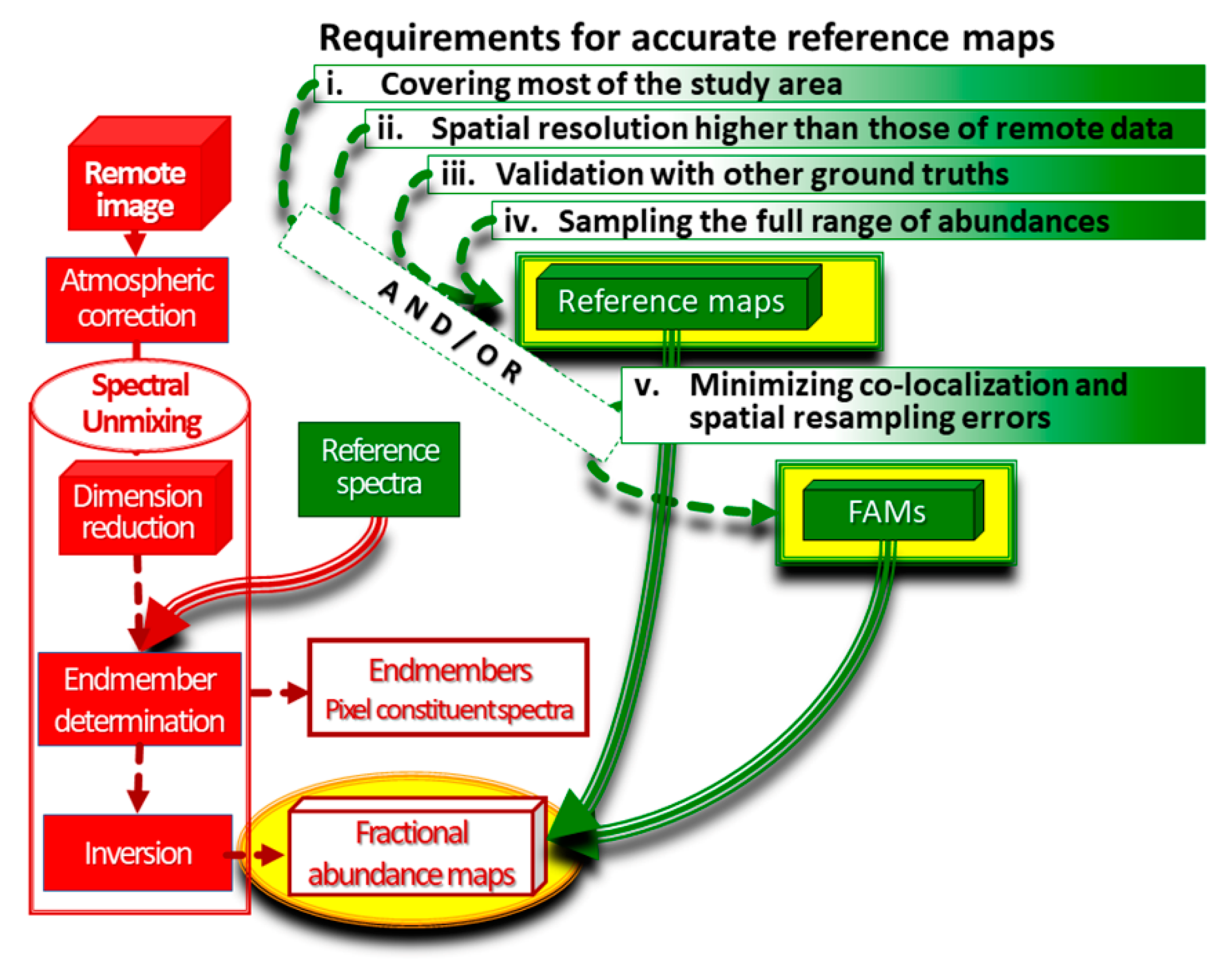
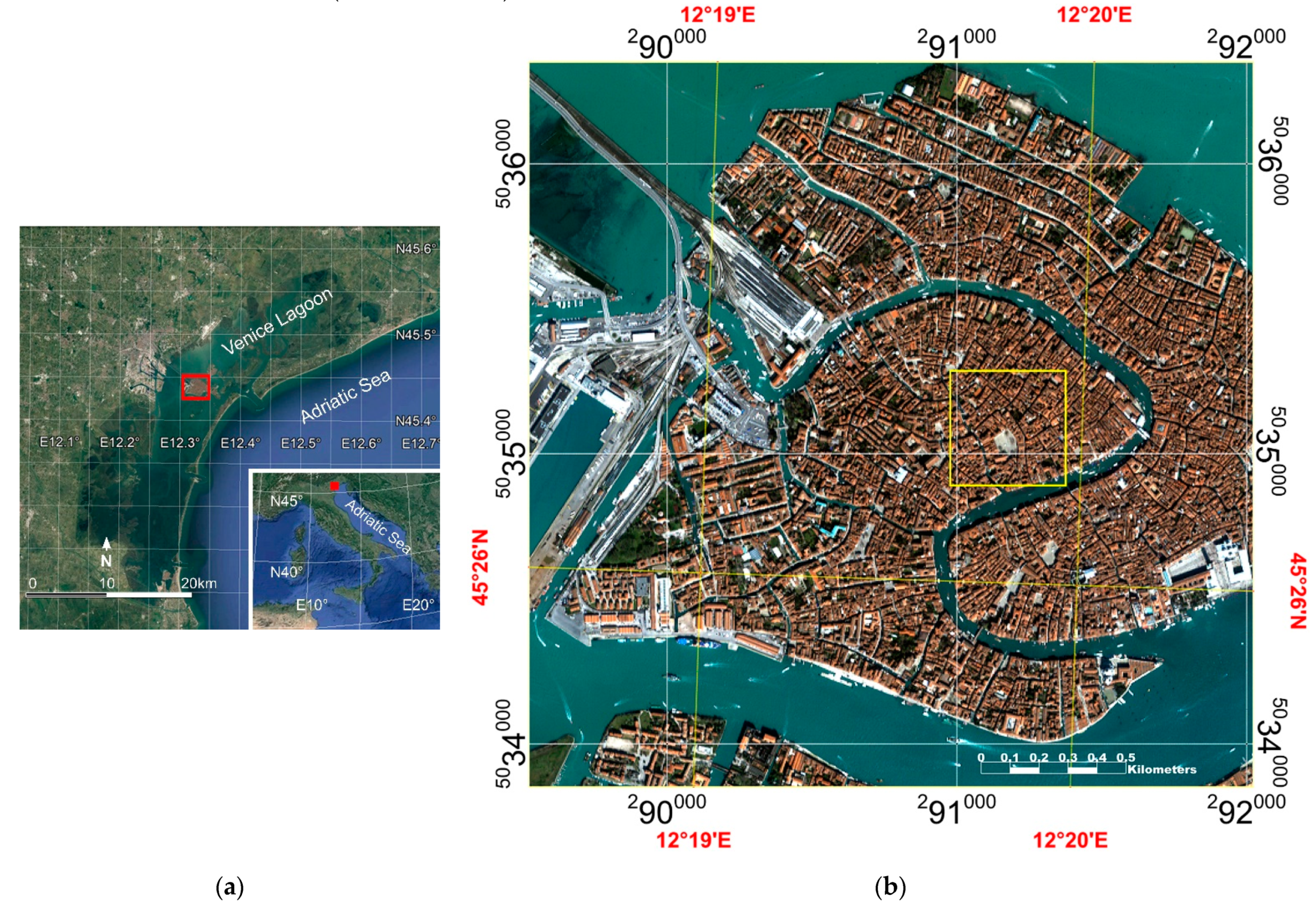
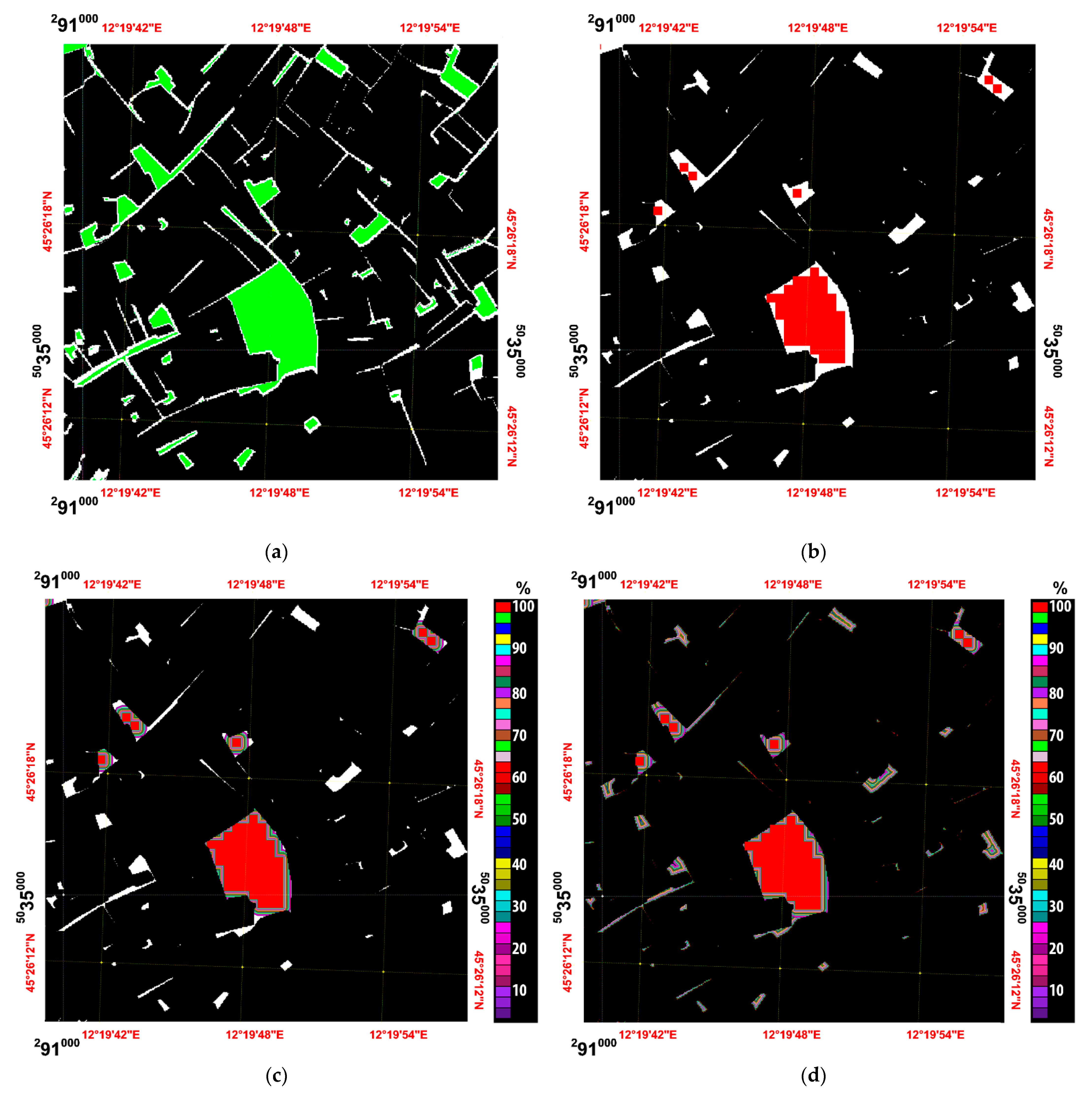
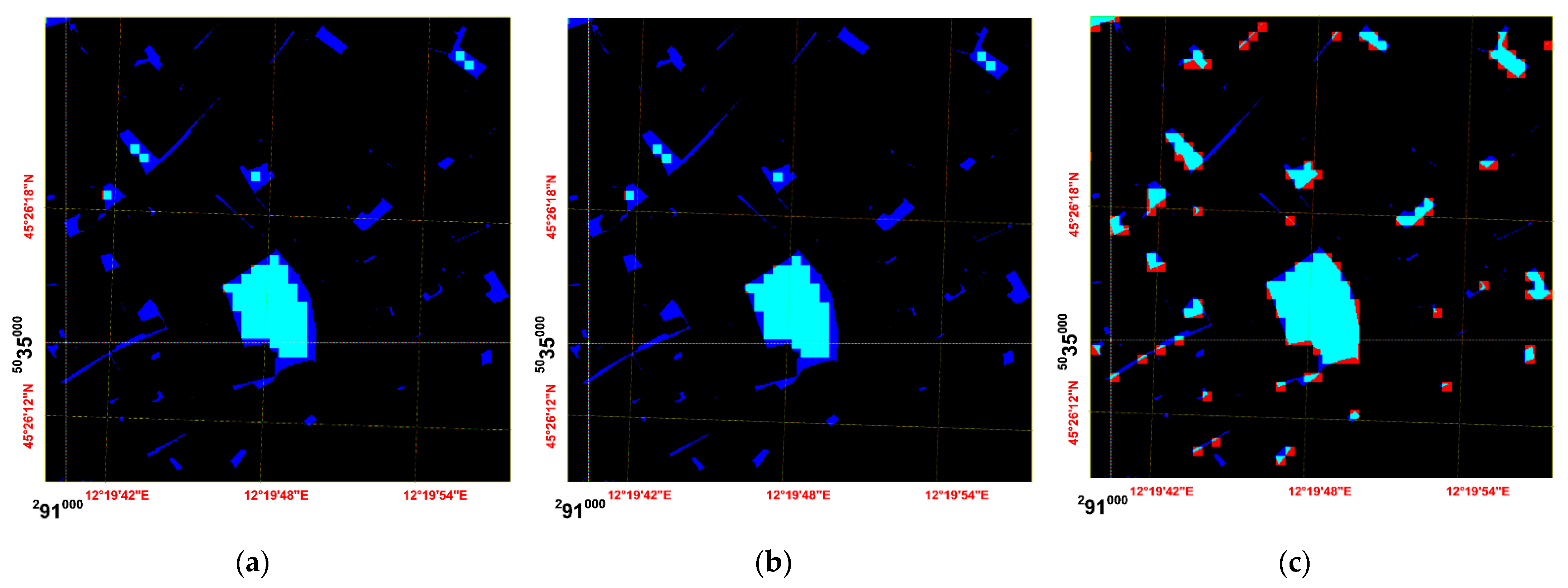
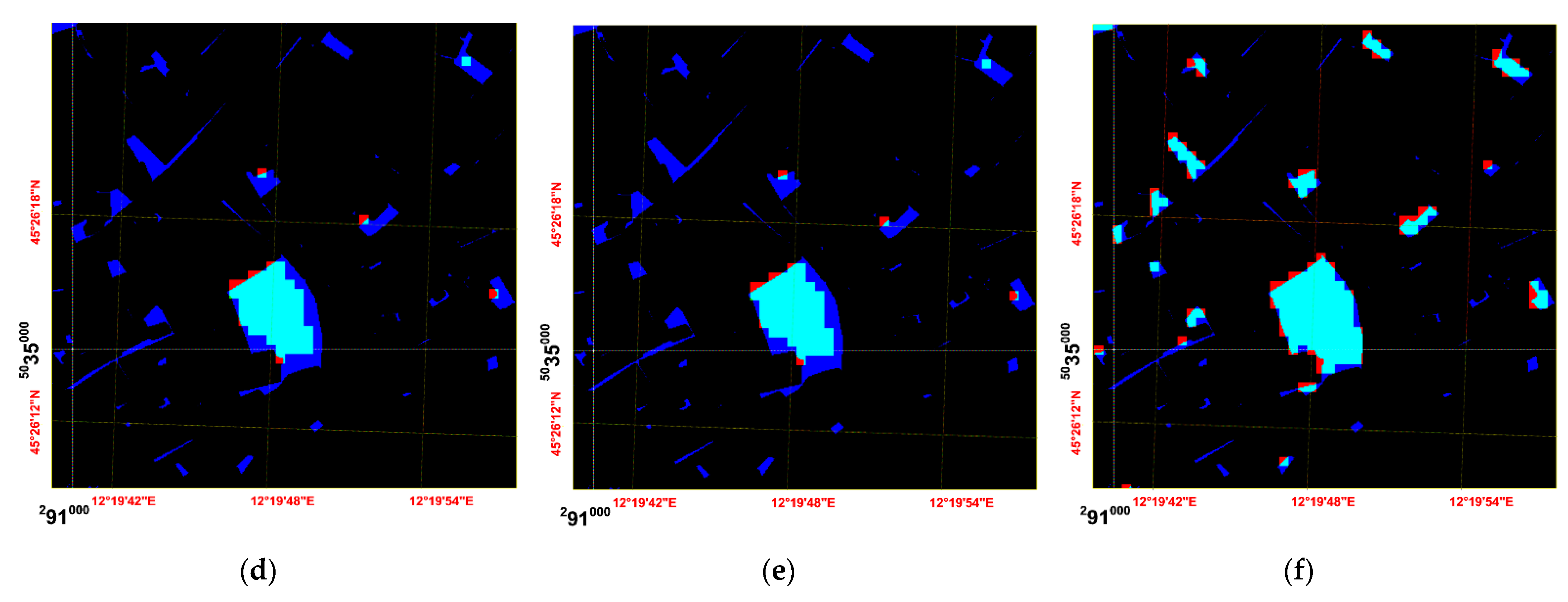
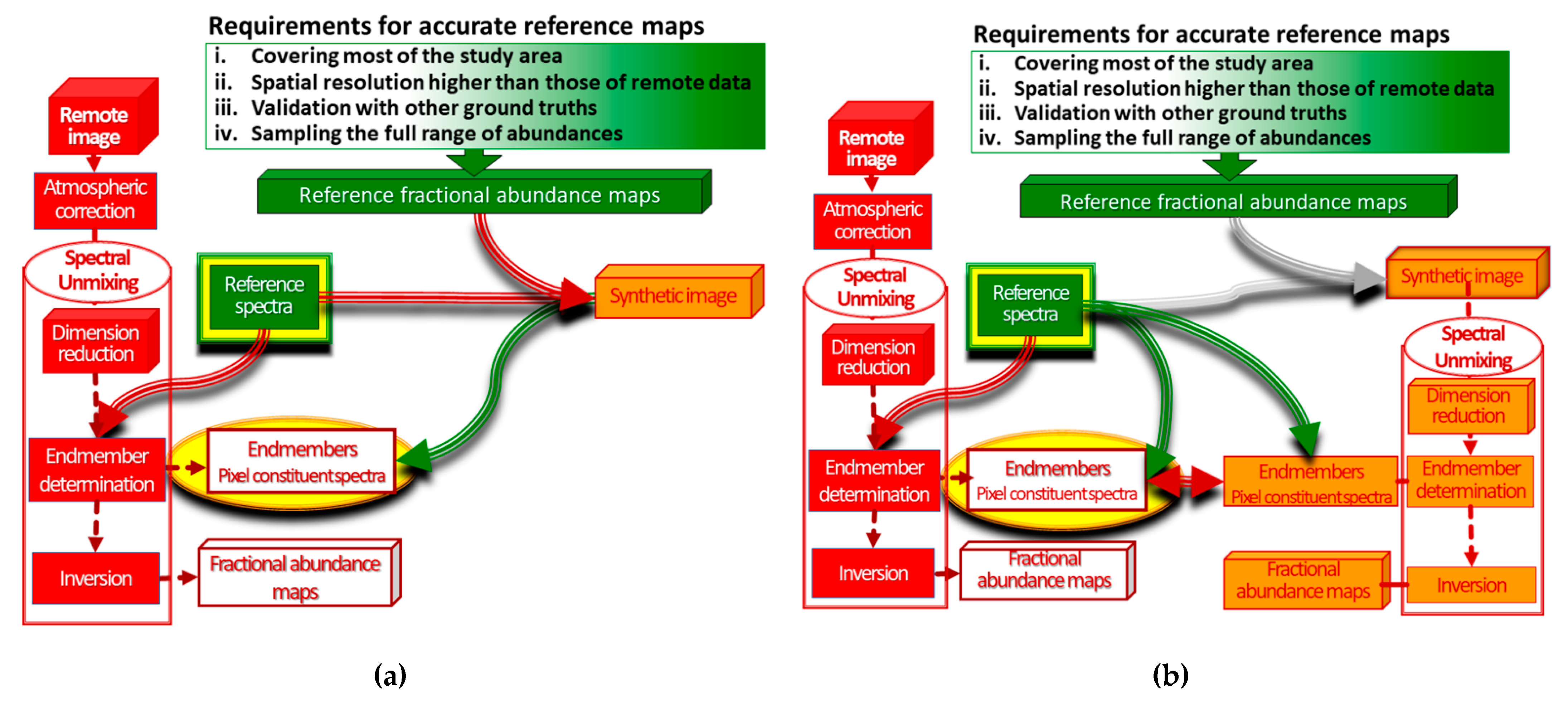
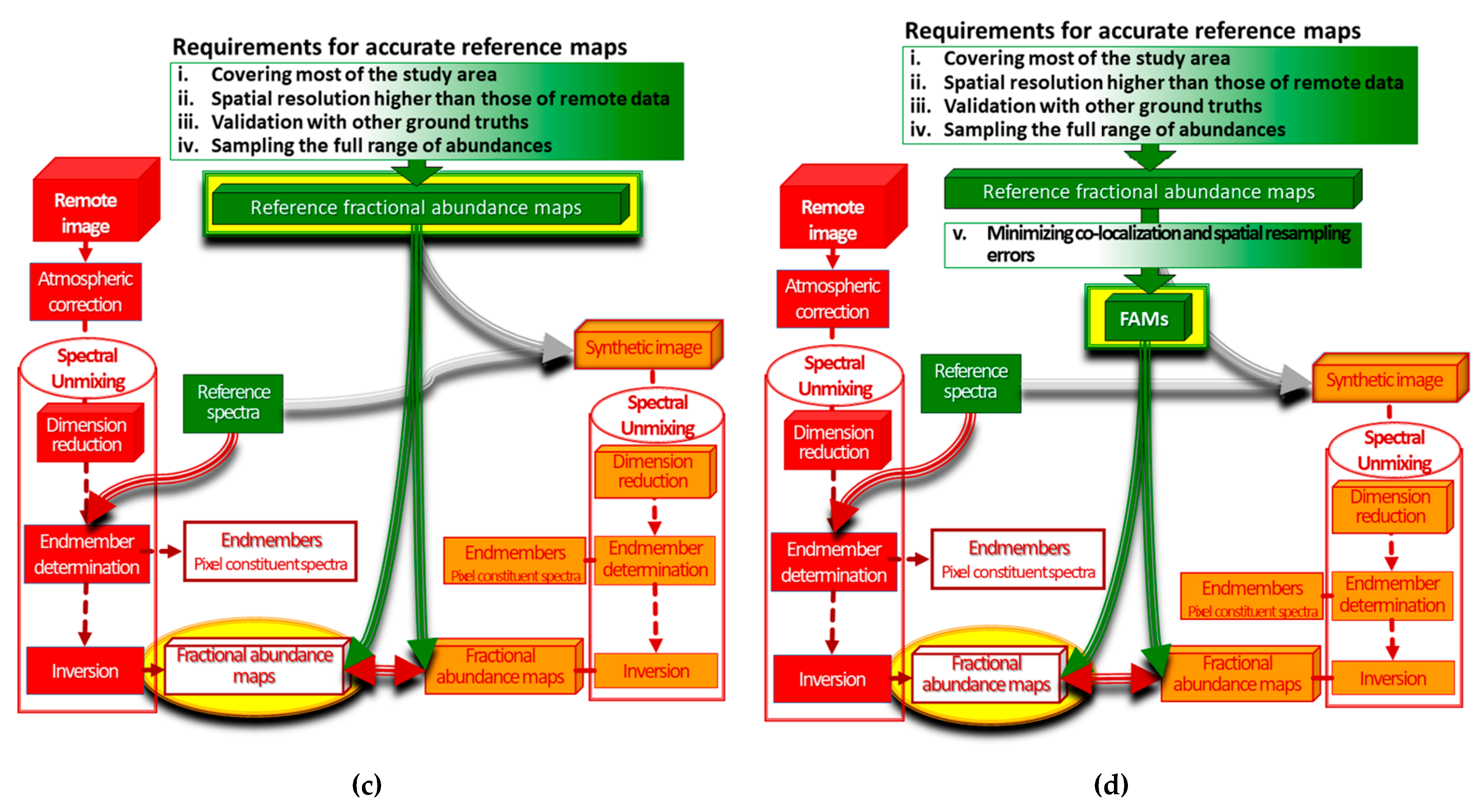

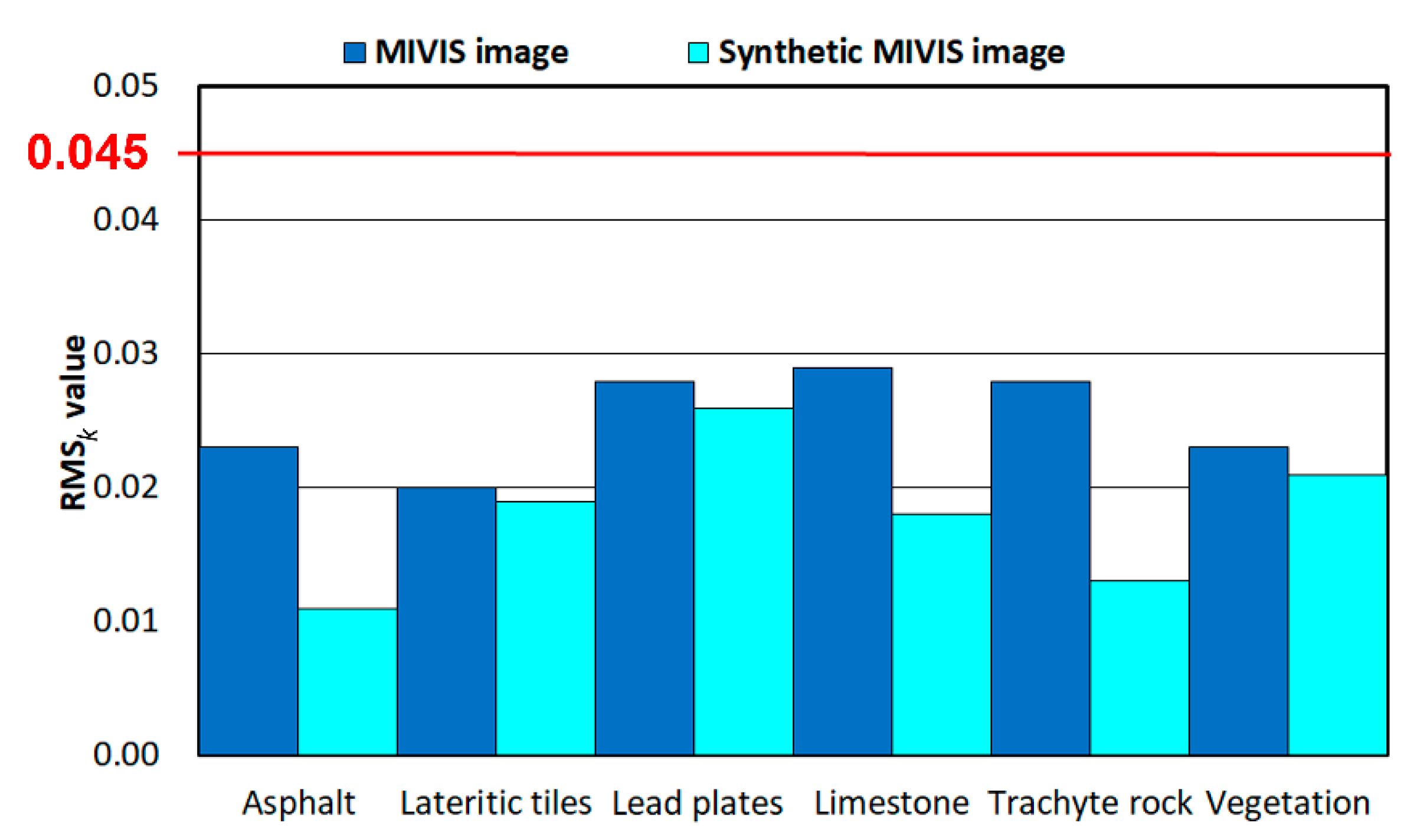



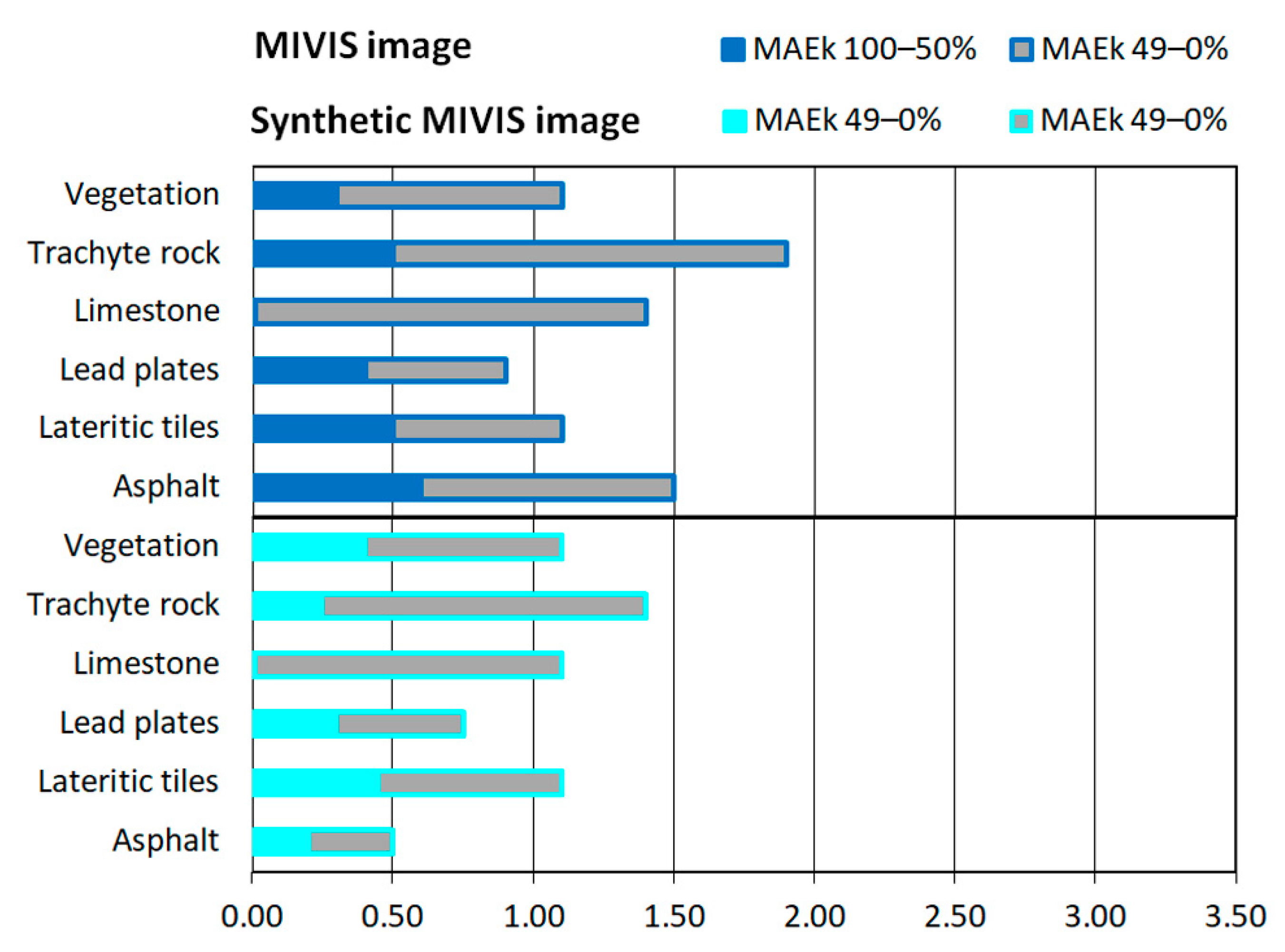
| Requirements for Accurate Reference Maps | Proposed by | Met by | |
|---|---|---|---|
| I° requirement | Covering most of the study area | [6] | Most of the authors |
| II° requirement | Spatial resolution higher than those of remote data | [18,37] | Most of the authors |
| III° requirement | Validation with other ground truths | [36,38,39] | [36,38,39] |
| IV° requirement | Sampling the full range of abundances | [12,33,37,39] | [12,33,37,39] |
| V° requirement | Minimizing co-localization and spatial resampling errors | [33] | [33] |
| KERRYPNX | Spatial Resolution (m) | Bands | Spectral Region | Spectral Resolution (μm) | Spectral Range (μm) |
|---|---|---|---|---|---|
| MIVIS | 8 | 20 | VIS | 0.02 | 0.4–0.83 |
| 8 | NIR | 0.05 | 1.15–1.55 | ||
| 64 | SWIR | 0.09 | 2–2.5 | ||
| 10 | TIR | 0.34–0.54 | 8.2–12.7 |
| Spectral Validation Methods | Reference Data Employed | Accuracy of the Pixel Constituent Spectra | |
| Error Measure | Similarity Measure | ||
| First (Figure 1a) | Reference spectra | RMSk | SADk—aSSMnk |
| Second (Figure 7a) | Spectra of synthetic image | SADk—aSSMnk | |
| Third (Figure 7b) | Pixel constituent spectra obtained from synthetic image | RMSk | |
| Spatial Validation Methods | Reference Data Employed | Accuracy of the Fractional Abundance Maps | |
| Error Measure | Similarity Measure | ||
| Fourth (Figure 7c) | Reference fractional abundance maps and fractional abundance maps obtained from synthetic image | MAEk | |
| Fifth (Figure 7d) | FAMs and fractional abundance maps obtained from synthetic image | MAEk | KGE |
| MIVIS Image | Synthetic MIVIS Image | ||
|---|---|---|---|
| Endmembers | RMSk | RMSk | ΔRMSk |
| Asphalt | 0.023 | 0.011 | 0.012 |
| Lateritic tiles | 0.020 | 0.019 | 0.000 |
| Lead plates | 0.028 | 0.026 | 0.002 |
| Limestone | 0.029 | 0.018 | 0.011 |
| Trachyte rock | 0.028 | 0.013 | 0.015 |
| Vegetation | 0.023 | 0.021 | 0.002 |
| MIVIS Image | ||||
|---|---|---|---|---|
| Endmembers | SADk | σSADk | aSSMnk | σaSSMnk |
| Asphalt | 0.361 | 0.123 | 0.558 | 0.395 |
| Lateritic tiles | 0.299 | 0.069 | 0.659 | 0.255 |
| Lead plates | 0.282 | 0.079 | 0.693 | 0.247 |
| Limestone | 0.379 | 0.129 | 0.498 | 0.423 |
| Trachyte rock | 0.387 | 0.143 | 0.485 | 0.417 |
| Vegetation | 0.361 | 0.083 | 0.677 | 0.251 |
| Synthetic MIVIS Image | ||||
| Endmembers | SADk | σSADk | aSSMnk | σaSSMnk |
| Asphalt | 0.282 | 0.060 | 0.653 | 0.293 |
| Lateritic tiles | 0.271 | 0.042 | 0.772 | 0.217 |
| Lead plates | 0.253 | 0.065 | 0.714 | 0.245 |
| Limestone | 0.286 | 0.035 | 0.581 | 0.245 |
| Trachyte rock | 0.281 | 0.062 | 0.649 | 0.312 |
| Vegetation | 0.302 | 0.051 | 0.718 | 0.195 |
| Endmembers | ΔSADk | ΔσSADk | ΔaSSMnk | ΔσaSSMnk |
| Asphalt | 0.079 | 0.063 | 0.095 | 0.102 |
| Lateritic tiles | 0.028 | 0.027 | 0.113 | 0.038 |
| Lead plates | 0.029 | 0.014 | 0.021 | 0.002 |
| Limestone | 0.093 | 0.094 | 0.083 | 0.178 |
| Trachyte rock | 0.106 | 0.081 | 0.164 | 0.105 |
| Vegetation | 0.059 | 0.032 | 0.041 | 0.056 |
| MIVIS Image | |||
|---|---|---|---|
| Endmembers | ErrorTotals | Error100–50% | Error49–0% |
| Asphalt | 44.4% | 33.3% | 50.0% |
| Lateritic tiles | 8.3% | 16.7% | 0.0% |
| Lead plates | 18.2% | 20.0% | 16.7% |
| Limestone | 39.1% | 0.0% | 39.3% |
| Trachyte rock | 36.7% | 0.0% | 44.0% |
| Vegetation | 26.7% | 25.0% | 27.3% |
| MIVIS Image | |||
|---|---|---|---|
| True | Synthetic | Difference | |
| Endmembers | KGE | KGE | KGE |
| Asphalt | −0.010 | 0.050 | 0.060 |
| Lateritic tiles | 0.150 | 0.315 | 0.165 |
| Lead plates | 0.170 | 0.720 | 0.550 |
| Limestone | −0.060 | 0.012 | 0.072 |
| Trachyte rock | −0.080 | −0.028 | 0.052 |
| Vegetation | 0.300 | 0.485 | 0.185 |
Publisher’s Note: MDPI stays neutral with regard to jurisdictional claims in published maps and institutional affiliations. |
© 2022 by the author. Licensee MDPI, Basel, Switzerland. This article is an open access article distributed under the terms and conditions of the Creative Commons Attribution (CC BY) license (https://creativecommons.org/licenses/by/4.0/).
Share and Cite
Cavalli, R.M. Spatial Validation of Spectral Unmixing Results: A Case Study of Venice City. Remote Sens. 2022, 14, 5165. https://doi.org/10.3390/rs14205165
Cavalli RM. Spatial Validation of Spectral Unmixing Results: A Case Study of Venice City. Remote Sensing. 2022; 14(20):5165. https://doi.org/10.3390/rs14205165
Chicago/Turabian StyleCavalli, Rosa Maria. 2022. "Spatial Validation of Spectral Unmixing Results: A Case Study of Venice City" Remote Sensing 14, no. 20: 5165. https://doi.org/10.3390/rs14205165







